When it comes to oscilloscopes, there are two main players in the game: Rigol and Tektronix. Both brands offer a range of options with varying features and prices, making it difficult for customers to choose one over the other. So which brand truly offers the better oscilloscope?
To answer this question, we must first consider the needs and priorities of the customer. Budget-conscious individuals may prefer Rigol oscilloscopes, as they tend to be more affordable while still offering reliable performance. On the other hand, those in need of high-end features such as multi-channel capabilities or advanced analysis functions may find that Tektronix offers a better fit for their needs.
In the article below, we will discuss the strengths and weaknesses of each brand in order to help customers make informed decisions.
Rigol Oscilloscopes Overview
Rigol, a Chinese company founded in 1998, offers a wide range of testing and measuring equipment including oscilloscopes, spectrum analyzers, and function generators. Their oscilloscope offerings include both digital storage (DS) and mixed-signal (MSO) models.
One major advantage of Rigol oscilloscopes is their affordability. Even their high-end models tend to be much more budget-friendly than comparable Tektronix options. Additionally, many customers have reported that the user interface is easy to navigate and understand.
However, some customers have found that Rigol oscilloscopes lack in performance when compared to Tektronix models. They may not offer as many advanced features or analysis capabilities, making them a less attractive option for those in need of high-end capabilities.
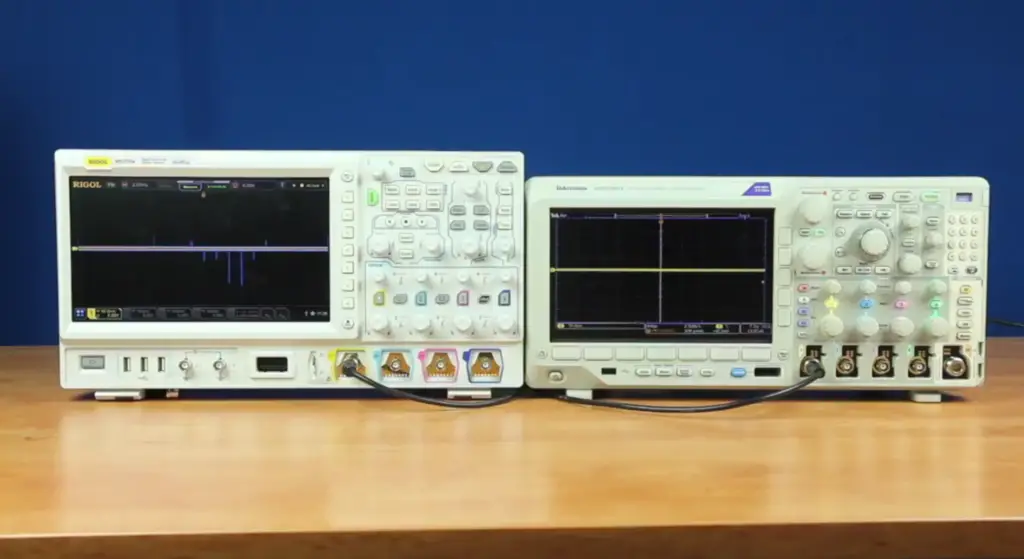
Tektronix Oscilloscopes Overview
Tektronix, founded in 1946, is a trusted and well-established brand in the testing and measurement industry. They offer a wide range of oscilloscope options including digital storage (DS), mixed-signal (MSO), and arbitrary function generators (AFG).
One major advantage of Tektronix oscilloscopes is their performance. Many customers have reported that they provide more reliable and accurate results, particularly for high-speed signals or advanced analysis tasks. Additionally, their user interface tends to be highly intuitive and easy to navigate.
However, this level of performance does come at a cost – Tektronix oscilloscopes tend to be much more expensive than Rigol options. They also may not have as many budget-friendly offerings for customers with more limited budgets.
Similarities Between Rigol vs. Tektronix Oscilloscopes
Both brands offer oscilloscopes with similar specs, such as bandwidth up to 1 GHz and sample rates up to 2 GSa/s. Both also offer models with built-in arbitrary waveform generators and various communication options (USB, LAN, etc.).
Among similarities, there are also some key differences to consider.
Additionally, Tektronix offers more options for advanced analysis and measurement capabilities, such as jitter and eye diagram analysis.
Also, both brands offer models with similar pricing, ranging from entry-level to high-end options.
Additionally, both Rigol and Tektronix offer software for remote control and data analysis.
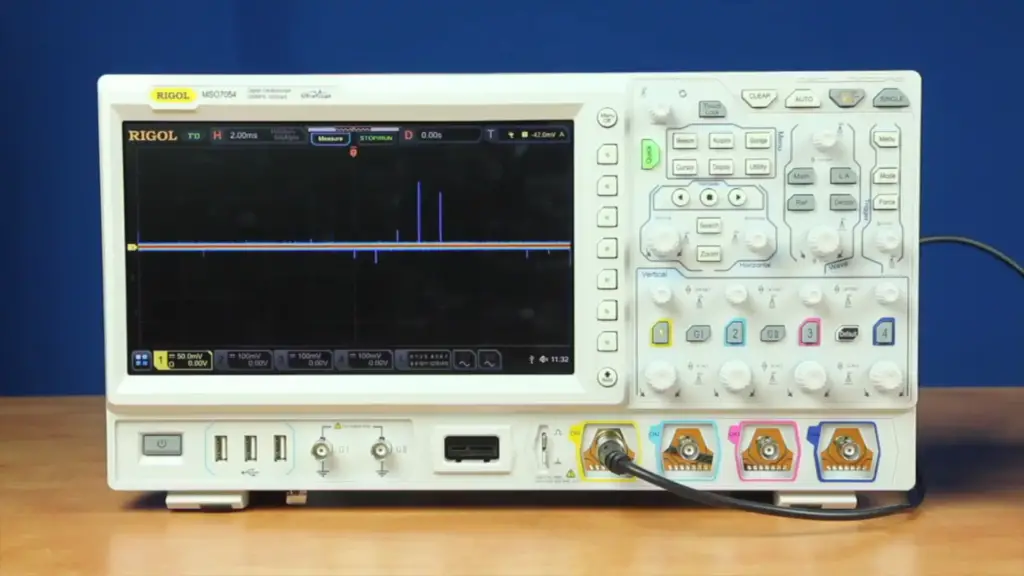
Differences Between Rigol vs. Tektronix Oscilloscopes
Usability and interface
Tektronix oscilloscopes are known for their intuitive, user-friendly interfaces.
On the other hand, Rigol oscilloscopes tend to have a steep learning curve and can be more difficult to navigate. However, some users prefer Rigol’s more customizable interface options.
Rigol’s user interface has been noted for its ease of use, while Tektronix offers more advanced features such as customizable color schemes and multiple language options. In terms of software, both companies offer extensive analysis capabilities including FFTs and waveform math.
Bandwidth
Rigol oscilloscopes generally offer lower maximum bandwidth than Tektronix oscilloscopes, with many models maxing out at 200 MHz compared to 500 MHz or higher for Tektronix.
This may not be an issue for basic use cases but could be a limitation for advanced applications that require high bandwidth.
Screen Size And Resolution
Tektronix oscilloscopes often have larger screens, with some models offering up to 15.6 inches compared to Rigol’s maximum of 10.1 inches.
In addition, Tektronix oscilloscopes tend to have higher screen resolutions, which can be important for viewing fine details or multiple traces on the screen at once.
Price
Rigol oscilloscopes tend to be more budget-friendly, with many models costing significantly less than comparable Tektronix options.
However, it is important to consider features and performance needs before making a purchasing decision based solely on price.
Menus, buttons, and knobs
Tektronix oscilloscopes often have more physical buttons and knobs for quick access to common functions, while Rigol oscilloscopes rely more heavily on menus for navigating the scope’s features.
Again, this may be a matter of personal preference – some users prefer the tactile experience of physical buttons, while others find menus to be more efficient.
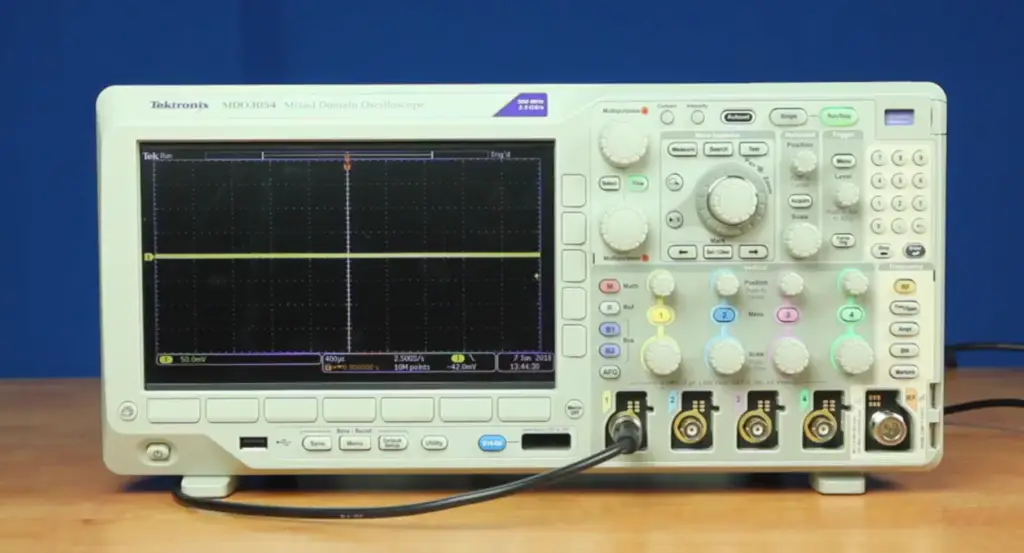
Cursors
Rigol oscilloscopes have more advanced cursor options, including the ability to automatically locate and measure waveform features.
Tektronix oscilloscopes do offer cursors and automated measurement options, but they may not be as comprehensive as those found on Rigol models.
Triggering
When it comes to triggering, both Rigol and Tektronix offer a wide range of options including edge, pulse width, slit, video, and alternate. However, Tektronix offers more advanced features such as pattern triggering and glitch capture.
Sample rate
Rigol’s maximum sample rate ranges from 1 GSa/s to 5 GSa/s whereas Tektronix has a maximum sample rate of 50 GSa/s.
Probes
Both Rigol and Tektronix offer active differential probes with a maximum bandwidth of 1 GHz. However, Tektronix also offers higher bandwidth options up to 20 GHz.
Computer integration
Both companies offer options for computer integration through USB, LAN, and GPIB. Tektronix also offers an additional option for wireless connectivity through Wi-Fi or Bluetooth.
Overall, it really depends on the specific needs of the user. If advanced triggering and higher bandwidth probes are necessary, then Tektronix may be the better option. However, if budget and ease of use are a priority, Rigol may be the way to go. It is important to carefully consider all features and weigh them against your individual requirements before making a decision.
For those who need advanced triggering options and high bandwidth probing, Tektronix may be the better choice. However, those looking for a straightforward user interface at a lower cost may prefer Rigol.
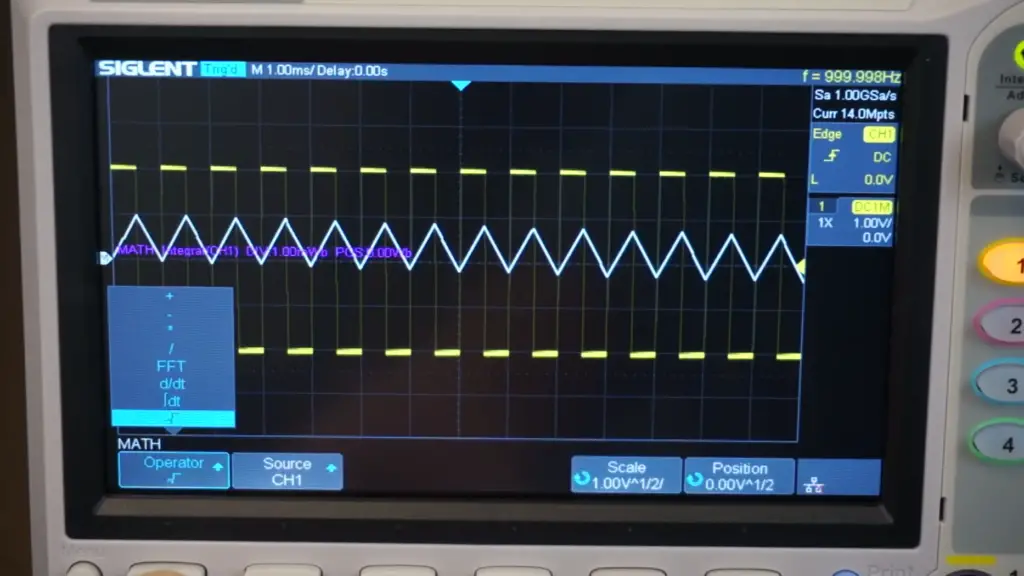
How To Choose A Reliable Oscilloscope
Bandwidth and Sample Rate
One of the most important considerations in choosing an oscilloscope is its bandwidth and sample rate. The bandwidth determines the maximum frequency that can be accurately measured, while the sample rate determines how many points can be captured per second.
Rise time
Another important specification to consider is the rise time or the amount of time it takes for a signal to go from 10% to 90% of its maximum amplitude. Faster rise times result in more accurate measurements and better resolution. Rigol offers a minimum rise time of 1.5ns, while Tektronix has a minimum of 0.35ns.
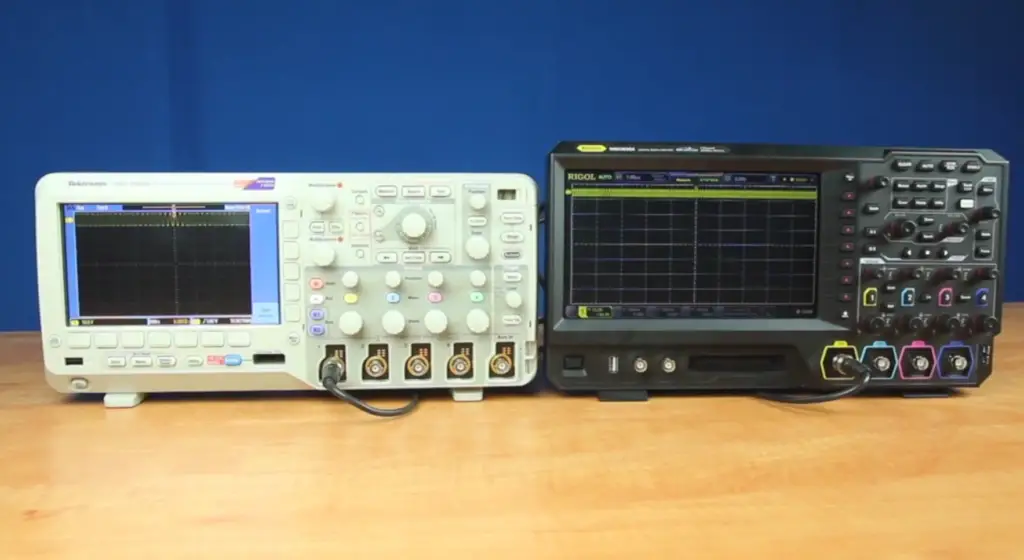
Additional Features
In addition to these technical specs, both brands offer a range of additional features that may be important for your specific application. These include built-in measurement functions, storage capabilities, and connectivity options such as USB or Ethernet. It’s important to carefully consider which features will be useful for your needs before making a decision on which oscilloscope to purchase.
Matching Probes and Accessories
When purchasing an oscilloscope, it’s also important to consider compatibility with probes and other accessories. Both Rigol and Tektronix offer a range of compatible probes, but make sure to check for compatibility before making a purchase.
Input Channels
In addition to considering the oscilloscope specs and features, it’s important to also consider how many input channels will be necessary for your application. Both Rigol and Tektronix offer options with up to 4 or 8 input channels.
Record Lengths
The record length, or the maximum number of points that can be captured in a single acquisition, is another important factor to consider. Rigol offers up to 1 Mpts record length, while Tektronix has options up to 25 Mpts.
Advanced Application Support
Finally, both Rigol and Tektronix offer support for advanced applications such as jitter and signal integrity analysis. However, it’s important to note that Tektronix offers more specialized solutions for these types of measurements.

FAQ
Where is Rigol manufactured?
Rigol is a Chinese company, with headquarters in Beijing and factories in Suzhou and Shanghai.
Where is Tektronix manufactured?
Tektronix is an American company, with headquarters in Beaverton, Oregon, and manufacturing facilities in the US, China, and Penang, Malaysia.
What do experts say about the performance of Rigol vs. Tektronix oscilloscopes?
Expert opinions vary, but many say that both brands offer high-quality products with similar performance capabilities. Ultimately, it may come down to personal preference and budget constraints. Some users prefer Rigol for its affordability and sleek user interface, while others prefer Tektronix for its robust software options and excellent customer support.
Which brand offers a wider range of oscilloscope models?
Tektronix offers a larger range of oscilloscope models, with options for different channels, bandwidths, and applications. However, Rigol also offers a wide selection of oscilloscopes to choose from.
How big is Tektronix?
Tektronix is a well-known and established company in the electronics measurement industry, with over 65 years of experience. They have a global reach, with offices in 26 countries and customers in more than 100 countries.
How big is Rigol?
Rigol is a newer player in the oscilloscope market, having only been founded in 1998. However, they have quickly gained a strong reputation for their high-quality and affordable products. They also have a global reach, with subsidiaries in North America, Europe, and Asia.
What does a digital oscilloscope do?
It can be used in a variety of industries, such as engineering, electronics, telecommunications, and more. Additionally, scopes can have various features and capabilities, making them an important tool for precise measurement and analysis.
Who are the major Tektronix competitors?
One major competitor is Rigol Technologies, a Chinese company that produces high-performance scopes at a lower price point than Tektronix. Other competitors include Agilent, Keysight, and LeCroy.
Does Fluke own Tektronix?
No, Fluke Corporation does not currently own Tektronix. While both companies produce test and measurement equipment, they are separate entities. Fluke is a multinational corporation based in Washington that specializes in industrial testing and measurement equipment, while Tektronix is a subsidiary of Fortive Corporation based in Oregon that focuses on electronic testing and measurement equipment.
How do you use a Tektronix oscilloscope
- First, you need to connect your device or signal to the input channels of the oscilloscope;
- Then, adjust the settings such as time and voltage scales to display the waveform accurately on the screen;
- Finally, you can analyze and measure specific aspects of the waveform using the built-in tools or cursors;
How do you use a Rigol oscilloscope?
Similar to a Tektronix oscilloscope, first you need to connect your device or signal to the input channels. Then, adjust the settings such as time and voltage scales, and utilize the built-in measurement tools for analysis.
How many types of oscilloscopes are there?
There are two main types of oscilloscopes: digital and analog. Digital oscilloscopes use computer technology to interpret signals and display data, while analog oscilloscopes use traditional electron beams to display waveforms on a screen.
What are the different types of oscilloscopes?
Before diving into the comparison between Rigol and Tektronix, it’s important to understand the different types of oscilloscopes that exist. Perhaps the most common type is a digital storage oscilloscope (DSO), which uses an analog-to-digital converter to convert electrical signals into digital data for display on a screen. Another type is a mixed signal oscilloscope (MSO), which can also display and analyze both analog and digital signals simultaneously.
Are all oscilloscopes the same?
To start, let’s look at the price. When it comes to entry-level models, Rigol tends to offer lower prices compared to Tektronix. However, as you move up in model options and added features, Tektronix tends to have higher prices. So if budget is a major factor in your decision-making process, Rigol may be the better option.
Next, let’s consider ease of use. Both Rigol and Tektronix offer user-friendly interfaces, but reviews suggest that Rigol’s menus and navigation are simpler and more intuitive. On the other hand, Tektronix offers more advanced features for experienced users.
When it comes to customer support, Tektronix has a clear edge with its 24/7 global support and comprehensive training options. Rigol also offers support, but it may not be as readily available in all regions.
What are the 3 main control sections of an oscilloscope
- The horizontal control section adjusts the time base or the speed at which the signal is plotted on the screen;
- The vertical control section adjusts the amplitude or the height of the signal on the screen;
- The trigger control section sets what conditions need to be met for the oscilloscope to start plotting a signal on the screen;
What are the limitations of oscilloscopes?
Before diving into the comparison between Rigol and Tektronix oscilloscopes, it’s important to note that all oscilloscopes have certain limitations. These limitations include limited bandwidth, sample rate, and record length.
How do I turn my old TV into an oscilloscope?
First, check to see if your TV has a video input port. If it doesn’t, you will need to buy an external video adapter.
Next, download oscilloscope software onto your computer and connect it to the TV via the video input port.
Finally, calibrate the screen using the software’s settings.
Keep in mind that using a TV as an oscilloscope may not give you the most accurate or precise readings compared to a dedicated oscilloscope device. It is also important to note that converting a TV into an oscilloscope may void any warranties on the device.
What is the difference between dual trace and dual beam?
Dual trace refers to the oscilloscope’s ability to display two separate signals on the screen at the same time. A dual beam, on the other hand, allows for simultaneous measurements of two signals with different vertical scales and offsets.
What is the difference between DPO and DSO?
One of the main differences between Rigol and Tektronix oscilloscopes is in their technology. While both brands offer DPO (Digital Phosphor Oscilloscopes) and DSO (Digital Storage Oscilloscopes) options, Tektronix also offers MSO (Mixed Signal Oscilloscope) options. These MSOs have the capability to display and analyze multiple analog and digital signals simultaneously, making them a popular choice for those working in complex electronic systems.
However, when it comes to pure performance, many reviewers note that Rigol’s DPOs tend to outperform Tektronix’s DPOs in terms of signal fidelity and capture rate. On the other hand, Tektronix’s DSOs often have more advanced triggering and analysis capabilities.
Rigol oscilloscopes tend to be less expensive than comparable Tektronix models. However, the exact choice ultimately depends on the specific needs and preferences of the user. Both brands offer high-quality options for those in need of reliable oscilloscopes.
Does the oscilloscope need ground?
The answer to this question depends on the specific oscilloscope in question and the type of measurement being taken. In general, most oscilloscopes require a ground connection in order to accurately measure voltage signals. However, some specialized oscilloscopes, such as those designed for use in high-voltage environments, may have isolated inputs that do not require a ground connection.
When it comes to comparing Rigol and Tektronix oscilloscopes, both brands offer models with isolated inputs that do not require a ground connection. However, it is important to carefully review the technical specifications of a particular model before making any assumptions about its grounding requirements.
How often does the oscilloscope be tested?
When it comes to testing oscilloscopes, it is important to note that there is no set frequency for testing. It really depends on the specific application and usage of the oscilloscope. However, it is generally recommended to test the instrument at least once a year or after any major events or changes in the environment that could potentially impact its performance.
How do you calibrate an oscilloscope?
There are a few steps involved in calibrating an oscilloscope:
- First, you will need to adjust the time base or horizontal scale and position;
- Next, you will need to adjust the vertical scale and position;
- Finally, you will need to adjust any extra features such as trigger level and coupling;
It is important to note that proper calibration should be done by a trained technician with the appropriate equipment and resources.
How many MHz for an automotive oscilloscope do I need?
One of the main considerations when comparing oscilloscopes is their bandwidth, or how high of a frequency they can measure. For automotive applications, most industry experts recommend at least 200 MHz for capturing signals from modern cars. Both Rigol and Tektronix offer options with more than 200 MHz bandwidth, including the Rigol DS2302E which has 250 MHz, and the Tektronix MDO3054 which has 350 MHz.
Is 50 MHz oscilloscope enough?
When it comes to oscilloscopes, the first question many users ask is about the bandwidth. Bandwidth refers to the maximum frequency that an oscilloscope can accurately measure and display. Ideally, you want your oscilloscope’s bandwidth to be higher than any signal you intend to measure.
What is the difference between oscilloscopes and picoscope?
One main difference between an oscilloscope and a picoscope is the input signal. An oscilloscope can handle higher voltage levels and has more versatile input options, while a picoscope usually only has one or two inputs and is better suited for low-voltage signals such as those found in electronics.
Another difference is the sampling rate. Oscilloscopes typically have higher maximum sampling rates, allowing for more precise measurements of high-frequency signals. Picoscopes, on the other hand, often have built-in data storage capabilities and can be used for long-term monitoring or recording of signals.
Is 100MHz enough for an oscilloscope?
It depends. For example, Rigol offers a wide range of oscilloscope options, with their DS1000Z series offering 100MHz-500MHz bandwidths.
Tektronix, on the other hand, offers even higher bandwidth options with their MSO/DPO5000 series reaching up to 6GHz.
But it’s not just about the numbers – it’s also important to consider how well these oscilloscopes perform in real-life situations. And in this aspect, Tektronix tends to have better signal fidelity and noise immunity.
Useful Video: Rigol DS1000 vs Tektronix TDS2000 – aliasing
References
- https://www.peerspot.com/products/comparisons/rigol-oscilloscopes_vs_tektronix-oscilloscopes
- https://www.testandmeasurementtips.com/how-to-select-an-oscilloscope/
- https://oscilloscopepros.com/rigol-ds1054z-oscilloscope/
- https://community.element14.com/products/roadtest/rv/roadtest_reviews/982/tektronix_tbs1102c_d_1
- https://www.circuitspecialists.com/blog/best-oscilloscope-for-hobbyists/
- https://oscilloscopepros.com/rigol-ds1054z-oscilloscope/
- https://community.element14.com/products/roadtest/rv/roadtest_reviews/982/tektronix_tbs1102c_d_1
- https://www.circuitspecialists.com/blog/best-oscilloscope-for-hobbyists/









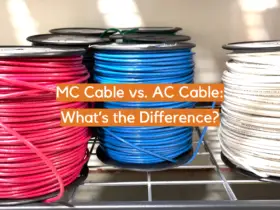



Leave a Reply